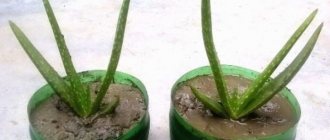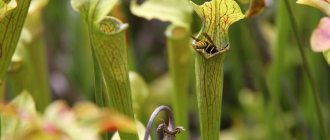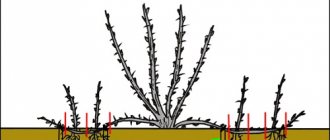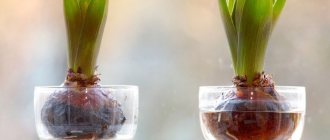Violet
Indoor violets are rooted with different fragments of the plant, but only leaf propagation produces several young shoots at once. To do this, take a container with holes in the bottom and a drainage layer consisting of expanded clay, pebbles or other available material.
Then it is filled with ready-made soil purchased in the store, or a substrate is made up of equal parts:
- turf soil;
- leaf humus;
- high peat;
- gravel.
The soil mixture is slightly moistened and a violet leaf cut from the middle tier of the rosette is placed on it. Too young leaf plates from the top or lower (old) ones are not suitable for rooting.
The planting material is cut across the veins in several places with a sharp (disinfected) blade and carefully pressed against the ground. You can even pin it with a toothpick so that the contact area is larger.
The container is covered with polyethylene (glass) and placed in a warm place, providing sufficient lighting.
After 1-2 weeks, tiny rosettes will appear at the incision sites. Periodically, the mini-greenhouse is opened so that the plant can breathe and condensation does not accumulate.
How to plant Chionodoxa and how they grow
How to propagate violet leaves at home
Chionodoxa photo bulbs
Chionodoxes grow very quickly, producing many daughter bulbs.
One adult bulb grows 2-4 daughter bulbs during the growing season. Sometimes young small bulbs that have not reached the flowering stage develop so-called contractile roots. They can diverge to the sides or go about 20 cm deep. By the end of the growing season (marked by drying of the leaves), this tap root takes the form of a carrot; at first it reaches a diameter of 10-15 mm, then becomes transparent and watery, wrinkles and quickly dries out. Thus, a void is formed into which the onion falls. Plants are distributed at different depths and do not interfere with each other. However, because of this, digging up bulbs turns into a long and painstaking process that cannot be mechanized; everything is done by hand.
Therefore, it is better to plant Chionodoxa in advance:
You can dig up and plant the bushes while they are still flowering - they will not suffer at all from this, but it is important not to allow the delicate roots to dry out; plant them immediately. If you dig at the end of the growing season (after the leaves turn yellow, which happens towards the end of May), carefully disassemble the nests of bulbs, put them in a box and store them in a dark, dry place with a cool air temperature. You can store them in the vegetable section of the refrigerator until September, and then plant them out.
When to plant Chionodoxa in the fall
Chionodox bulbs (purchased or those dug up in the spring) are best planted in early autumn (September), so that before the onset of cold weather they have time to build up a powerful root system, necessary for successful wintering and lush vegetation in the spring.
How to plant Chionodox bulbs
In the fall, plant the bulbs in open ground:
- Planting depth 5-8 cm
- The distance between the bulbs is about 5 cm.
- After planting, mulch the surface with a 3-5 cm layer of humus.
Flowering will occur next season.
Begonia
Any variety of begonia can be easily rooted using a cut leaf with a cutting - it can be placed in soft, clean water or directly planted in the soil.
In order to obtain several shoots at once, the leaf plate, as in the case of violets, is laid on moist soil and transverse cuts are made.
Begonia prefers light, nutritious soil with good permeability to moisture, air and a slightly acidic reaction (pH - 5.5-6.5 units).
If you do not have the opportunity to buy ready-made soil, you can make it yourself. To do this take:
- 2 parts leaf turf;
- 2 hours of high-moor peat;
- 1 tsp coarse river sand;
- 1 teaspoon of matured compost or humus.
The soil is slightly moistened and maintained in this condition until roots 2-2.5 cm in size appear on the planting material.
Bulbs
What indoor plants are good for your health?
Bulbous plants are divided into two groups: evergreen (crinums, etc.) and deciduous, with a more or less long cessation of growth - a dormant period (lilies, hyacinths, daffodils, tulips, etc.). These are widespread, very valuable plants, propagated for forcing in winter, for cutting and for beautiful flower decoration in gardens and parks. Bulbs of evergreen plants are separated, like root suckers, in the spring after flowering. Planted in pots in light soil. Later, after rooting, they are transferred to heavier soil. Bulbs of deciduous plants used for indoor forcing are selected at the end of summer after digging from open ground, dried in the shade for a month and planted in pots in the fall. According to the structure of the bulbs, they can be filmy (hyacinths, tulips, daffodils) or scaly (lilies). In membranous bulbs, “baby” bulbs are formed on the sides from the axillary buds; In this case, the uterine bulb is greatly depleted and even disappears.
To get as many “baby” bulbs as possible, old, faded hyacinth bulbs are cut crosswise from the bottom, hollowed out or drilled out at the bottom, or simply cut out the middle part of the bulb. This technique destroys the middle bud, instead of which several baby bulbs are formed, and the bulbs disappear.
The bulbs of each variety, dried in summer, are planted in separate pots. Pots with planted bulbs are placed in a dark room with an air temperature of 6–8 ° C and good ventilation, covered with sand, peat chips with a layer of 10–12 cm or covered with moss. Watering is usually not necessary. The bulbs begin to grow 40–50 days after planting. They should be moved into the room only when the sprouts reach 5 cm in height and good rooting occurs (with earlier forcing, about 30–40, with later forcing, 10–15 days before the desired flowering date). In the first 10–15 days of forcing, the plants must be covered with cups of opaque paper or overturned pots in order to slow down the growth of leaves and promote a faster emergence of flower shoots. It is also necessary to cover the sprouts for the following reasons: when transferred to a room, the plants immediately find themselves in a drier atmosphere, and under the hood the air is more humid, so that they gradually get used to the air of the room, and also become accustomed to the transition from darkness to light.
The temperature for forcing in the first 2 days is 12–13°C, then 22–24°C. This can be achieved by placing the pots on the windowsill further or closer to the heat source. Flowering plants need a temperature of 8–10°C. In such conditions, flowering will last longer.
Forced plants should be watered regularly, but very carefully, from a watering can without a sieve, along the edge of the pot, so that water does not get between the leaves into the neck of the bulb, which can cause the plant to rot and die. After flowering, the bulbs are left in pots until the foliage completely dies, then transplanted into open ground. The suitability of the bulbs for forcing is determined by the degree of their development
The suitability of the bulbs for forcing is determined by the degree of their development
In this case, not only the size of the bulb is taken into account, but also its weight. Lightweight bulbs, although large, are not used for forcing, but for spring flowering on the balcony, in the winter garden or flower bed. Propagation of bulbs of tulips, daffodils and other bulbous plants is carried out in the same way, but only mechanical damage to the bulbs (incision, gouging) is not used.
Propagation of bulbs of tulips, daffodils and other bulbous plants is carried out in the same way, but only mechanical damage to the bulbs (incision, gouging) is not used.
Scaly lily bulbs easily reproduce without outside help and produce a large number of “babies”. Lilies can also be propagated from bulb scales, stem leaves and stem layerings.
Home — Propagation of indoor plants — Division by tubers and corms
Crassula
Like all succulents, the crassula, or money tree, takes root easily with the help of any fragment separated from a mature plant. It is enough for a fleshy leaf cut from the crown to touch the moist soil.
In order to root a Crassula leaf, you don’t have to put in much effort. A plant completely covered with aerial roots has high viability.
You can buy a substrate for a succulent at a flower shop or prepare it yourself from equal parts:
- turf land;
- humus;
- vermiculite;
- gravel.
A prerequisite is that the soil must be well drained, because... Money tree does not tolerate excessive moisture.
Vegetative propagation
Vegetative propagation of plants is quite widespread in nature, but most often it is used by people to cultivate ornamental plants and agricultural crops.
Vegetative propagation is a very productive method of reproduction for plant organisms, since it does not necessarily require the presence of genetic material from another individual. In addition, vegetative propagation occurs quite quickly and significantly saves the body’s resources, both energetic and physiological. The negative side of this type of reproduction is the fact that it does not provide genetic diversity and there is a high probability of death of individuals at an early stage of development, since vegetative reproduction depends on too many environmental factors, including humans.
Are you an expert in this subject area? We invite you to become the author of the Directory Working Conditions
Note 1
Despite the fact that plants are most often propagated by cuttings, vegetative propagation by leaves is also quite widespread.
Ficus
Even a novice gardener can cope with the propagation of ficus. The leaf plate is separated from the crown with a sharp, disinfected knife.
During this process, a thick, sticky juice begins to secrete at the cut site, which should be washed with warm water. The sheet plate is left to dry for a couple of hours.
Then several shallow longitudinal cuts are made at the base of the cutting, this stimulates the growth of young roots. The prepared sheet is placed in a jar of clean water at room temperature.
In order to speed up the process of root formation, cover the container with a plastic bag. The mini-greenhouse is sometimes ventilated.
How to trim a cutting correctly
On a plant that is planned to be propagated by cuttings, the desired branch is cut off. For a cut branch, an oblique cut must be immediately made under the lower bud, and the leaf must be removed.
When cutting from indoor plants that have milky sap, such as ficus, you must place the cut cutting under running water until the sap stops flowing.
The cut cuttings must have at least one or two buds, from which a new young plant will subsequently grow. It is not advisable to dwell on the question of the number of buds on a cutting. Ficus can be propagated by cuttings with one single bud, but in this case the chances of getting a new plant will be much less than with cuttings with two buds.











